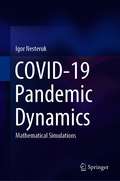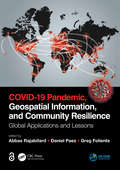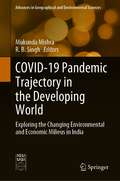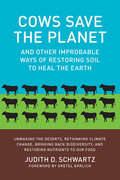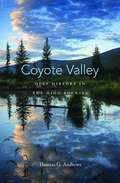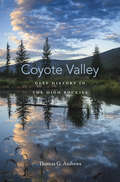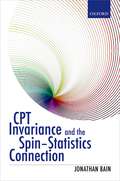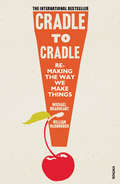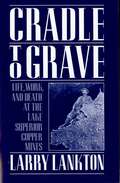- Table View
- List View
COVID-19 in Italy: Social Behavior and Governmental Policies
by Lucia Velotti Gabriella Punziano Felice AddeoAs the COVID-19 crisis began to take shape, all eyes were on Italy, the first Western country to attempt a response to the deadly pandemic. For institutional decision makers and average citizens alike, it was a time of deep uncertainty. As scientists struggled to understand the nature of the virus and how it spread, the gradualness with which information became available caused only deeper uncertainty, as did the inevitable disagreements over which protective actions the government should put in place. Despite some initial delay in its response, the Italian government eventually implemented a nationwide lockdown, which helped control the spread of the disease but simultaneously created unintended consequences for vulnerable populations, like small business owners, women, the elderly, and workers living paycheck to paycheck. Drawing on data surveys conducted during the transition between the first lockdown and staged reopening, this book examines people's risk perception and their willingness to trust the sources and channels of the information that were available to them. It also looks at their attitudes toward the protective behaviors they were asked to adopt, and the ways in which their own cultural worldviews impacted their support for pandemic response policies. With remarkable depth and candor, respondents reflected on what a post-COVID-19 Italy might look like, filling out the book with the hopes and fears of real people who had stared death and the face and lived to tell about it. The book looks ahead to possibilities for future research, policy, and practice. COVID-19 in Italy elaborates and tests several aspects of the Protective Action Decision Model (PADM) in the Italian context, introducing the concept of ontological security and insecurity as an explanatory change factor to help interpret the Italian experience of responding to COVID-19.
COVID-19 Lockdowns and the Urban Poor in Harare, Zimbabwe: Emerging Perspectives and the Morphing of a Sustainable Urban Future
by Johannes Itai Bhanye Fortune Mangara Abraham R. Matamanda Lameck KachenaThis book focuses on the socio-economic impacts of the COVID-19 pandemic and associated lockdowns on the welfare of the urban poor in the city of Harare, Zimbabwe. The authors look through the lenses of the urban health penalty, the right to the city, complexity theory, and distributive justice theory. These four theories help situate the COVID-19 pandemic and its impacts on the urban poor in the theoretical foundations that raise issues of how the poor are affected by disease/health pandemics, due to their living conditions. Uniquely, the authors use remote ethnography tools such as rich texts, video diaries and photo uploads to provide evidence-based stories of how COVID-19 mobility restrictions have affected poor urbanites in Harare.The book concludes that the COVID-19 pandemic mandatory lockdowns have deepened social and spatial inequality among the urban poor, threatening their right to the city. The socio-economic impacts can upsurge poverty, increase unemployment and the risks of hunger and food insecurity, reinforce existing inequalities, and break social harmony in the cities, even past the COVID-19 pandemic period. These socioeconomic impacts must be considered to make just cities for all, from a right-to-the-city perspective. The authors recommend that mandatory COVID-19 lockdowns should not only be treated as a law-and-order operation but as a medical intervention to stem the spread of the virus backed by measures to safeguard the livelihoods of the urban poor while also protecting the economy. This means governments should provide social safety nets to informal sector operators whose income-generating activities are affected the most during the time of emergencies like COVID-19. Planners and policymakers should re-envision pandemic-resilient cities that are just, equitable, resilient, and sustainable.
COVID-19 Pandemic Dynamics: Mathematical Simulations
by Igor NesterukThis book highlights the estimate of epidemic characteristics for different countries/regions in the world with the use of known SIR (susceptible-infected-removed) model for the dynamics of the epidemic, the known exact solution of the linear differential equations and statistical approach developed before. The COVID-19 pandemic is of great interest to researchers due to its high mortality and a negative impact to the world economy. Correct simulation of the pandemic dynamics needs complicated mathematical models and many efforts for unknown parameters identification. The simple method of detection of the new pandemic wave is proposed and SIR model generalized. The hidden periods, epidemic durations, final numbers of cases, the effective reproduction numbers and probabilities of meeting an infected person are presented for countries like USA, Germany, UK, the Republic of Korea, Italy, Spain, France, the Republic of Moldova, Ukraine, and for the world. The presented information is useful to regulate the quarantine activities and to predict the medical and economic consequences of different/future pandemics.
COVID-19 Pandemic, Geospatial Information, and Community Resilience: Global Applications and Lessons
by Abbas RajabifardGeospatial information plays an important role in managing location dependent pandemic situations across different communities and domains. Geospatial information and technologies are particularly critical to strengthening urban and rural resilience, where economic, agricultural, and various social sectors all intersect. Examining the United Nations' SDGs from a geospatial lens will ensure that the challenges are addressed for all populations in different locations. This book, with worldwide contributions focused on COVID-19 pandemic, provides interdisciplinary analysis and multi-sectoral expertise on the use of geospatial information and location intelligence to support community resilience and authorities to manage pandemics.
COVID-19 Pandemic, Geospatial Information, and Community Resilience: Global Applications and Lessons
by Abbas Rajabifard Daniel Paez Greg FolienteGeospatial information plays an important role in managing location dependent pandemic situations across different communities and domains. Geospatial information and technologies are particularly critical to strengthening urban and rural resilience, where economic, agricultural, and various social sectors all intersect. Examining the United Nations' SDGs from a geospatial lens will ensure that the challenges are addressed for all populations in different locations. This book, with worldwide contributions focused on COVID-19 pandemic, provides interdisciplinary analysis and multi-sectoral expertise on the use of geospatial information and location intelligence to support community resilience and authorities to manage pandemics.
COVID-19 Pandemic Trajectory in the Developing World: Exploring the Changing Environmental and Economic Milieus in India (Advances in Geographical and Environmental Sciences)
by Mukunda Mishra R. B. SinghWe are witnessing an unprecedented global outbreak of COVID-19, which has been devastating in its consequences. Beyond the acute health hazard, the pandemic has carried with it other threats for mankind associated with the human economy, society, culture, psychology and politics. Amidst these multifarious dimensions of the pandemic, it is high time for global solidarity to save humankind.Human society, its ambient environment, the process of socio-economic development, and politics and power – all are drivers to establish the world order. All these parameters are intimately and integrally related. The interconnections of these three driving forces have a significant bearing on life, space and time. In parallel, the interrelationship between all these drivers is dynamic, and they are changed drastically with time and space. The statistics serve to align the thought, based on which social scientists need to understand the prevailing equation to project the unforeseen future. The trajectory of the future world helps in planning and policymaking with a scientific direction.The practitioners of all academic disciplines under the umbrella of the social sciences need a common platform to exchange ideas that may be effective in the sustainable management of the crisis and the way forward after it is mitigated. This book provides multidisciplinary contributions for expressing the solidarity of academic knowledge to fight against this global challenge. It is crucial that there should be an on-going discussion and exchange of ideas, not only from the perspective of the current times but keeping in view the preparedness for unforeseen post-COVID crises as well.
COVID-19, Tourist Destinations and Prospects for Recovery: Volume Three: A South African and Zimbabwean Perspective
by Kaitano Dube Olga L. Kupika David ChikodziThere has been a segmented approach to documenting the impact of COVID-19 and recovery prospects for global tourism destinations. Until this volume, though, there has not been comprehensive, concentrated efforts to take a deep-dive look into two countries’ tourism destinations in order to provide a comparative perspective. This book fills this gap by analyzing tourism impacts and recovery prospects in both Zimbabwe and South Africa. The volume opens with an introductory chapter from the editors that provide context and background. Part I of the volume looks at the impacts of COVID-19 on Zimbabwe and South Africa, Part II focuses on tourism operations during the pandemic, and Part III focuses on tourism recovery initiatives and prospects. The concluding chapter from the editors provides practical and policy implementation. This book is the third and final component of a three-volume set on the impact of COVID-19 on destination tourism around the world.
COVID-19, Tourist Destinations and Prospects for Recovery: Volume Two: An African Perspective
by Kaitano Dube Ishmael Mensah Lazarus ChapunguDespite the fact that the African tourism industry is prone to disturbances such as diseases, extreme weather events, civil unrest, wars, and other shocks, nothing could have prepared this destination for the devastating effect of the COVID-19 pandemic. In the absence of government or international agency budget support, the pandemic challenged the African tourism market to its core. The focus of this book is to assess the impact of the COVID-19 pandemic on the African tourism destination market as well as its prospects for recovery. A chapter written by the editorial team introduces the book. Following the introduction, the book offers chapters evaluating the pandemic's impact on African tourism. Chapters in the second part of the book discuss tourism recovery and how some destinations have survived the pandemic. The book concludes with a chapter providing policy recommendations and practical implementation advice. The book is part of a 3 volume series.
COVID-19, Tourist Destinations and Prospects for Recovery: Volume One: A Global Perspective
by Kaitano Dube Godwell Nhamo Mp SwartThe COVID-19 pandemic had a devastating impact on tourist destinations in developing and developed countries. Though the entire globe was impacted, the short- and long-term implications for tourism as well as prospects for recovery vary across regions. This volume showcases research on the impact of COVID-19 on tourism from across the world. The book is divided into three parts, with the stage set by an introductory chapter that will provide a background and context. Part I contains chapters that explore the impact of COVID-19 on selected international tourist destinations. Part II showcases how various hotspots across the world adjusted to the new normal under pandemic conditions. Part III is a collection of chapters that address how various destinations are attempting to recover from the shocks of the COVID-19 pandemic. The concluding chapter, written by the editors, seeks to synthesize the lessons offered in the book and provide policy and practical implementation for the tourism industry and other important tourism stakeholders.
COVID in the Islands: A comparative perspective on the Caribbean and the Pacific
by John Connell Yonique CampbellThis book provides the first wide-ranging account of the impact of the COVID-19 pandemic in two contrasting island regions - the Caribbean and the Pacific - and in several islands and island states. It traces the complexity of effects and responses, at different scales, through the first critical year. Written by a range of scholars and practitioners working in the region the book focuses on six key themes: public health; the economies (notably the collapse of tourism, the revival of local agriculture and fishing, and the rebirth of self-reliance, and even barter); the rescue by remittances; social tensions and responses; public policy; and future ‘bubbles’ and regional connections. Even with marine borders that excluded the virus all island states were affected by COVID-19 because of a considerable dependence on tourism – prompting urgent challenges for governance, economic management and development, as small states sought to balance lives against livelihoods in search of revitalisation or even a ‘new normal’.
Coworking Spaces: Alternative Topologies and Transformative Potentials
by Janet Merkel Dimitris Pettas Vasilis AvdikosThis contributed volume considers the emergence of coworking as centered in labor issues. More specifically, its chapters consider it as a coping mechanism in the worldwide rise of independent modes of work (i.e., self-employment) that leaves more and more workers exposed to precarity as they must organize and manage their own labor. Grounded in this perspective, this volume aims to understand the transformative social and political potentials emerging through coworking as a social and spatial practice. There is a distinct lack of discussion within coworking research on the emancipatory potentials of coworking—and if it is discussed, more cautionary views prevail, highlighting the ambivalence of coworking spaces both as a space of alternative economic practices and as integrated into market economies. The aims of this collection are twofold: First, it aims to make visible the plurality of existing practices around shared resources in coworking and the assemblages of human and non-human actors as agents of change associated with coworking and the re-organization of work and labor power. And second, it aims to develop a more emancipatory narrative for coworking and the role of coworking spaces for workers but also the different spatial contexts in which these spaces are situated. A narrative that does not emphasize entrepreneurship or coworking as the epitome of the ‘neoliberal entrepreneurial self’ as in the dominant interpretations in the current research, but rather one that centers coworking in the creation of meaningful, careful social relationships, supporting empathy and an ethics that recognizes mutual interdependencies and builds a foundation for social change. So, it is about alternative narratives, emancipation politics and the wider social role that coworking spaces might play in neighborhoods, cities or beyond because they are crucial contexts for the formation and maintenance of social relations. With this specific direction, this collection aims to bring coworking research into a fruitful dialog with other research fields-such as sociology of work, feminist perspectives on care, alternative and diverse economies, "post-capitalist" transformation, critical geography, positioning coworking within a range of progressive alternatives in the articulation of economic and social relationships.
Cows Save the Planet: And Other Improbable Ways of Restoring Soil to Heal the Earth
by Judith Schwartz Gretel EhrlichIn Cows Save the Planet, journalist Judith D. Schwartz looks at soil as a crucible for our many overlapping environmental, economic, and social crises. Schwartz reveals that for many of these problems—climate change, desertification, biodiversity loss, droughts, floods, wildfires, rural poverty, malnutrition, and obesity—there are positive, alternative scenarios to the degradation and devastation we face. In each case, our ability to turn these crises into opportunities depends on how we treat the soil. Drawing on the work of thinkers and doers, renegade scientists and institutional whistleblowers from around the world, Schwartz challenges much of the conventional thinking about global warming and other problems. For example, land can suffer from undergrazing as well as overgrazing, since certain landscapes, such as grasslands, require the disturbance from livestock to thrive. Regarding climate, when we focus on carbon dioxide, we neglect the central role of water in soil—"green water"—in temperature regulation. And much of the carbon dioxide that burdens the atmosphere is not the result of fuel emissions, but from agriculture; returning carbon to the soil not only reduces carbon dioxide levels but also enhances soil fertility. Cows Save the Planet is at once a primer on soil's pivotal role in our ecology and economy, a call to action, and an antidote to the despair that environmental news so often leaves us with.
Coxeter Graphs and Towers of Algebras (Mathematical Sciences Research Institute Publications #14)
by Frederick M. Goodman Pierre de Harpe Vaughan F.R. JonesA recent paper on subfactors of von Neumann factors has stimulated much research in von Neumann algebras. It was discovered soon after the appearance of this paper that certain algebras which are used there for the analysis of subfactors could also be used to define a new polynomial invariant for links. Recent efforts to understand the fundamental nature of the new link invariants has led to connections with invariant theory, statistical mechanics and quantum theory. In turn, the link invariants, the notion of a quantum group, and the quantum Yang-Baxter equation have had a great impact on the study of subfactors. Our subject is certain algebraic and von Neumann algebraic topics closely related to the original paper. However, in order to promote, in a modest way, the contact between diverse fields of mathematics, we have tried to make this work accessible to the broadest audience. Consequently, this book contains much elementary expository material.
Coyote America: A Natural and Supernatural History
by Dan FloresThe New York Times best-selling account of how coyotes--long the target of an extermination policy--spread to every corner of the United States Finalist for the PEN/E.O. Wilson Literary Science Writing Award"A masterly synthesis of scientific research and personal observation." -Wall Street JournalLegends don't come close to capturing the incredible story of the coyote In the face of centuries of campaigns of annihilation employing gases, helicopters, and engineered epidemics, coyotes didn't just survive, they thrived, expanding across the continent from Alaska to New York. In the war between humans and coyotes, coyotes have won, hands-down. Coyote America is the illuminating five-million-year biography of this extraordinary animal, from its origins to its apotheosis. It is one of the great epics of our time.
Coyote Valley: Deep History in the High Rockies
by Thomas G. AndrewsThomas Andrews drills deep into the many pressures that have reshaped a small stretch of North America, from the ice age to the advent of the Anthropocene and controversies over climate change. He brings to the surface lessons about the critical relationships to land, climate, and species that only seemingly unimportant places on Earth can teach.
Coyote Valley: Deep History in the High Rockies
by Thomas G. AndrewsThomas Andrews drills deep into the many pressures that have reshaped a small stretch of North America, from the ice age to the advent of the Anthropocene and controversies over climate change. He brings to the surface lessons about the critical relationships to land, climate, and species that only seemingly unimportant places on Earth can teach.
CPT Invariance and the Spin-Statistics Connection
by Jonathan BainThis book seeks to answer the question "What explains CPT invariance and the spin-statistics connection?" These properties play foundational roles in relativistic quantum field theories (RQFTs), are supported by high-precision experiments, and figure into explanations of a wide range of phenomena, from antimatter, to the periodic table of the elements, to superconductors and superfluids. They can be derived in RQFTs by means of the famous CPT and Spin-Statistics theorems; but, the author argues, these theorems cannot be said to explain these properties, at least under standard philosophical accounts of scientific explanation. This is because there are multiple, in some cases incompatible, ways of deriving these theorems, and, secondly, because the theorems fail for the types of theories that underwrite the empirical evidence: non-relativistic quantum theories, and realistic interacting RQFTs. The goal of this book is to work towards an understanding of CPT invariance and the spin-statistics connection by first providing an analysis of the necessary and sufficient conditions for these properties, and second by advocating a particular account of explanation appropriate for this context.
CR Manifolds and the Tangential Cauchy Riemann Complex (Studies in Advanced Mathematics)
by Al BoggessCR Manifolds and the Tangential Cauchy Riemann Complex provides an elementary introduction to CR manifolds and the tangential Cauchy-Riemann Complex and presents some of the most important recent developments in the field. The first half of the book covers the basic definitions and background material concerning CR manifolds, CR functions, the tangential Cauchy-Riemann Complex and the Levi form. The second half of the book is devoted to two significant areas of current research. The first area is the holomorphic extension of CR functions. Both the analytic disc approach and the Fourier transform approach to this problem are presented. The second area of research is the integral kernal approach to the solvability of the tangential Cauchy-Riemann Complex. CR Manifolds and the Tangential Cauchy Riemann Complex will interest students and researchers in the field of several complex variable and partial differential equations.
CR Manifolds and the Tangential Cauchy Riemann Complex (Studies in Advanced Mathematics)
by Al BoggessCR Manifolds and the Tangential Cauchy Riemann Complex provides an elementary introduction to CR manifolds and the tangential Cauchy-Riemann Complex and presents some of the most important recent developments in the field. The first half of the book covers the basic definitions and background material concerning CR manifolds, CR functions, the tangential Cauchy-Riemann Complex and the Levi form. The second half of the book is devoted to two significant areas of current research. The first area is the holomorphic extension of CR functions. Both the analytic disc approach and the Fourier transform approach to this problem are presented. The second area of research is the integral kernal approach to the solvability of the tangential Cauchy-Riemann Complex. CR Manifolds and the Tangential Cauchy Riemann Complex will interest students and researchers in the field of several complex variable and partial differential equations.
A Crack in the Edge of the World: The Great American Earthquake of 1906 (Wheeler Hardcover Ser.)
by Simon WinchesterA burgeoning new city is built on the dreams of the American gold rush. It is also built upon a landscape that has been stretching, sliding and breaking apart for millennia. In 1906 the dreams of this city came crashing down beneath the rippling wave of a horrifying earthquake that turned roads into great rippling rivers, that set buildings ablaze for days on end, that made homes collapse upon themselves. Simon Winchester's breathtaking story delves deep beneath the surface of the earth and explains to us why the world moves as it does; and breaks apart with such devastating results. At the same time he never lets us forget the human story: what happened in this new, seemingly blessed city on the 18th April 1906. As he vividly portrays the lives of the people who suffered and survived the devastation he also tells a universal story: the hubris of man as he ignores the warnings of nature and how we respond and try to understand the world around us. Compelling, moving and enlightening, Simon Winchester brings to light the world beneath our feet and through the story of this one terrifying event one hundred years ago, begins to make sense of our world now.
Cracking the Carbon Code: The Key to Sustainable Profits in the New Economy
by T. TamminenHolds critical information that is needed by anyone who wants to understand how to make money from 'green' technology and how to avoid investments that will soon suffer from hidden carbon liabilities. Readers will learn to de-code a crucial component of this new economic driver - carbon credits, the world's first common currency.
Crackling Noise: Statistical Physics of Avalanche Phenomena
by Stefano ZapperiThe response of materials and the functioning of devices is often associated with noise. In this book, Stefano Zapperi concentrates on a particular type of noise, known as crackling noise, which is characterized by an intermittent series of broadly distributed pulses. While representing a nuisance in many practical applications, crackling noise can also tell us something useful about the microscopic processes ruling the materials behavior. Each crackle in the noise series usually corresponds to a localized impulsive event, an avalanche, occurring inside the material. A distinct statistical feature of crackling noise, and of the underlying avalanche behavior, is the presence of scaling, observed as power-law distributed noise pulses, long-range correlation, and scale free spectra. These are the hallmarks of critical phenomena and phase transitions. This work summarizes the current understanding of crackling noise, reviewing research undertaken in the past 30 years, from the early and influential ideas on self-organized criticality in sandpile models, to more modern studies on disordered systems. Crackling Noise covers the main theoretical models used to investigate avalanche phenomena, describes the statistical tools needed to analyze crackling noise, and provides a detailed discussion of a set of relevant examples of crackling noise in materials science. These include acoustic emission in fracture, strain bursts in amorphous and crystal plasticity, granular avalanches, magnetic noise in ferromagnets and superconductors, and fluid flow in porous media. The book concludes by considering the wider application of these models in the natural sciences.
Cradle of Life: The Discovery of Earth's Earliest Fossils
by J. William SchopfOne of the greatest mysteries in reconstructing the history of life on Earth has been the apparent absence of fossils dating back more than 550 million years. We have long known that fossils of sophisticated marine life-forms existed at the dawn of the Cambrian Period, but until recently scientists had found no traces of Precambrian fossils. The quest to find such traces began in earnest in the mid-1960s and culminated in one dramatic moment in 1993 when William Schopf identified fossilized microorganisms three and a half billion years old. This startling find opened up a vast period of time--some eighty-five percent of Earth's history--to new research and new ideas about life's beginnings. In this book, William Schopf, a pioneer of modern paleobiology, tells for the first time the exciting and fascinating story of the origins and earliest evolution of life and how that story has been unearthed. Gracefully blending his personal story of discovery with the basics needed to understand the astonishing science he describes, Schopf has produced an introduction to paleobiology for the interested reader as well as a primer for beginning students in the field. He considers such questions as how did primitive bacteria, pond scum, evolve into the complex life-forms found at the beginning of the Cambrian Period? How do scientists identify ancient microbes and what do these tiny creatures tell us about the environment of the early Earth? (And, in a related chapter, Schopf discusses his role in the controversy that swirls around recent claims of fossils in the famed meteorite from Mars.) Like all great teachers, Schopf teaches the non-specialist enough about his subject along the way that we can easily follow his descriptions of the geology, biology, and chemistry behind these discoveries. Anyone interested in the intriguing questions of the origins of life on Earth and how those origins have been discovered will find this story the best place to start.
Cradle to Cradle: (Patterns of the Planet) (Patterns Of Life Ser.)
by Michael Braungart William McDonoughRecycling is good, isn’t it? In this visionary book, chemist Michael Braungart and architect William McDonough challenge this status quo and put forward a manifesto for an intriguing and radically different philosophy of environmentalism."Reduce, reuse, recycle”. This is the standard “cradle to grave” manufacturing model dating back to the Industrial Revolution that we still follow today. In this thought-provoking read, the authors propose that instead of minimising waste, we should be striving to create value. This is the essence of Cradle to Cradle: waste need not to exist at all. By providing a framework of redesign of everything from carpets to corporate campuses, McDonough and Braungart make a revolutionary yet viable case for change and for remaking the way we make things.
Cradle to Grave: Life, Work, and Death at the Lake Superior Copper Mines
by Larry LanktonConcentrating on technology, economics, labor, and social history, Cradle to Grave documents the full life cycle of one of America's great mineral ranges from the 1840s to the 1960s. Lankton examines the workers' world underground, but is equally concerned with the mining communities on the surface. For the first fifty years of development, these mining communities remained remarkably harmonious, even while new, large companies obliterated traditional forms of organization and work within the industry. By 1890, however, the Lake Superior copper industry of upper Michigan started facing many challenges, including strong economic competition and a declining profit margin; growing worker dissatisfaction with both living and working conditions; and erosion of the companies' hegemony in a district they once controlled. Lankton traces technological changes within the mines and provides a thorough investigation of mine accidents and safety. He then focuses on social and labor history, dealing especially with the issue of how company paternalism exerted social control over the work force. A social history of technology, Cradle to Grave will appeal to labor, social and business historians.


